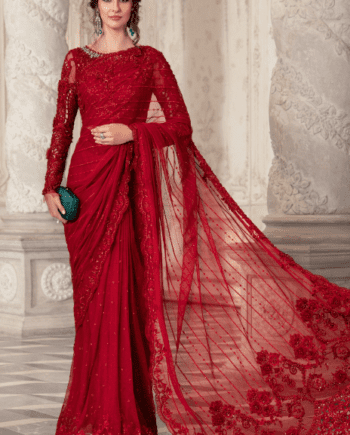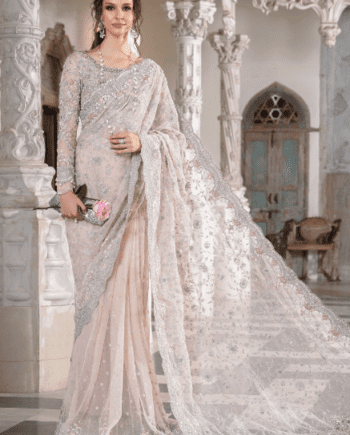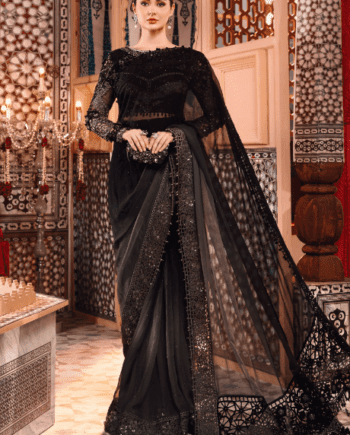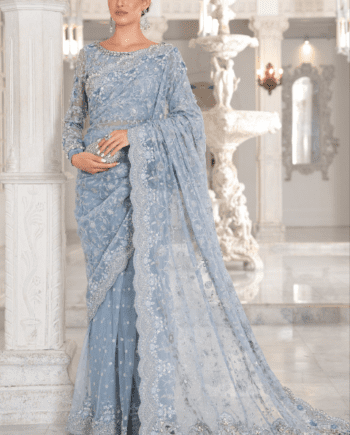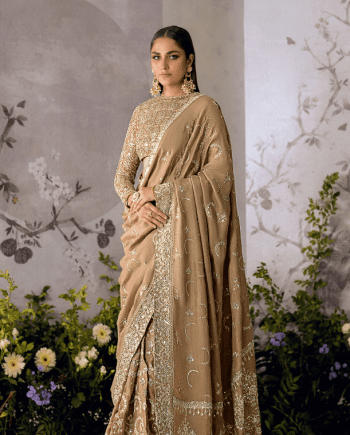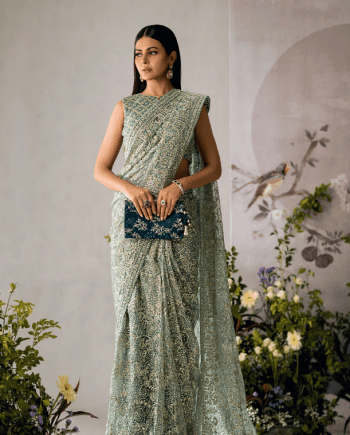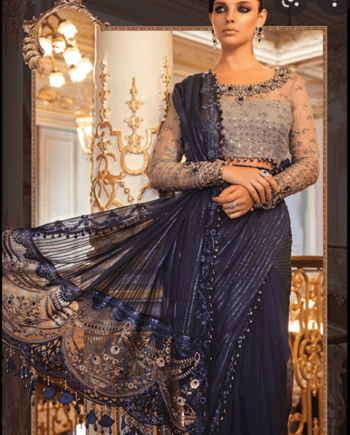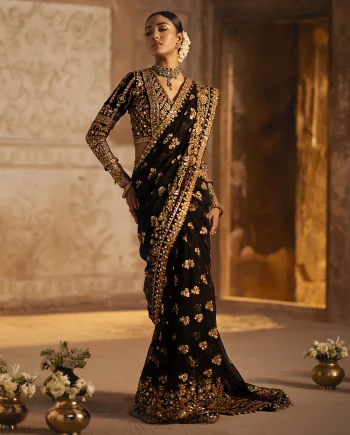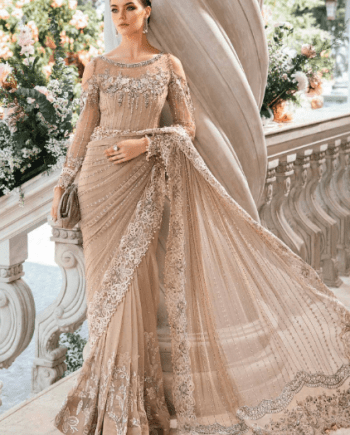The saree, often called the ‘Six-Yard Wonder,’ stands out as a complete and elegant attire. This timeless piece is not just clothing; it’s a piece of history, surviving through millennia as the world’s oldest unstitched garment. The saree is a canvas for weavers and printers, allowing them to create artistic weaves, prints, and embellishments.
The saree, or sari, is a famous Indian attire worn not only in India but worldwide. Its sensuality has captivated attention for centuries, making women look elegant, gorgeous, and stylish. Ranging from 3.5 to 9 yards, the saree is incredibly versatile and suitable for various occasions.
Whether draped in the West, East, or North, the saree can be worn in different styles, showcasing its adaptability and beauty. With a variety of colors, designs, and fabrics, sarees are essential in every Indian woman’s wardrobe.
Looking for that authentic charm of the saree at a saree shop near me? where you can explore modern, fancy sarees during a saree sale? Read on.
History of Saree
The saree has a rich history, dating back to the Indus Valley Civilization (2800 – 1800 BC). Today, it seamlessly blends Indian and international styles, often showcased in high-end fashion shows and exhibitions.
The term ‘sari’ originated from ‘sattika,’ meaning a women’s attire, found in early Jain and Buddhist scriptures. Originally a three-piece ensemble, it included Antriya (lower garment), Uttariya (veil worn over the shoulder or head), and Stanapatta (chest band).
This set was known as Poshak. The evolution continued, with the dhoti worn by men possibly influencing the Antriya, eventually transforming into the Bhairnivasani or skirt, known today as ‘ghagra’ or ‘lehenga.’
Similarly, Uttariya became the dupatta, and Stanapatta evolved into the choli.
In places like Jhansi, UP, historical records show women preferred the dhoti style for riding horses or swimming, and this influenced the traditional Maharashtrian saree draping. The sari, typically 5.5 to 8 meters long and around 1 meter wide, is commonly wrapped around the waist with pleats in front and draped over the shoulder.
The blouse and petticoat became integral during the Mughal and British eras and continue to be part of the modern saree ensemble. This timeless garment, with its cultural evolution, remains the perfect choice to enhance the beauty of women in the sub-continent.
Different Styles of Saree
The saree, a timeless garment, reflects diversity in its geographic and ethnic roots.
Each region in India has a unique way of draping the saree, showcasing distinct styles and identities. The plethora of colours, weaves, textures, and patterns make sarees a cultural treasure.
Shop: Asim Jofa New Collection
Geographical Roots: Exploring the Diversity of Indian Sarees
Silk Sarees
- Patola (Gujarat): Known for its vibrant patterns and precision in weaving.
- Banarasi (Varanasi, UP): Exquisite silk with intricate gold and silver brocade work.
- Kanjivaram (Tamil Nadu): Renowned for its rich silk and elaborate zari work.
- Gadwal (Andhra Pradesh): Blends silk and cotton, featuring distinctive zari borders.
- Paithani (Maharashtra): Recognized for its peacock and flower motifs in vibrant colors.
Cotton Sarees
- Bomkai, Khandua, Sambalpuri (Odisha): Known for Ikat patterns and traditional craftsmanship.
- Tant (Bengal): Lightweight cotton sarees with artistic threadwork.
- Mangalgiri (Andhra Pradesh): Cotton sarees with a distinctive zari border.
- Narayanpet (Maharashtra): Famous for its checks and contrasting borders.

Tribal and Unique Sarees
- Kodpad (Tribal Odisha): Represents the tribal culture with unique designs.
- Manipuri (Manipur): Features bright colors and unique patterns.
- Baluchari (Bengal): Depicts mythological scenes in silk, showcasing the artistry.
- Printed and Tie-Dye Sarees
Geographical Prints
- Bandhani, Leheriya, Bagru, Ajrakh, Sungudi (Rajasthan, Gujarat, Tamil Nadu): Tie-dye and block-print sarees with region-specific patterns.
- Kota (Rajasthan): Known for its lightweight, transparent fabric with distinctive square patterns.
- Kalamkari (Andhra Pradesh): Features hand-painted or block-printed designs, showcasing antique art.

Handloom Sarees: Exquisite Weaves
- Banarasi (UP): Luxurious silk with intricate gold and silver brocade.
- Kanchipuram (Tamil Nadu): Heavy silk sarees with contrasting borders and pallu.
- Chanderi, Maheshwari (Madhya Pradesh): Lightweight sarees with fine silk and zari work.
- Ghicha (West Bengal): Features a rustic look with a blend of silk and cotton.
Shop: Maria B Stitched Suits Online
How the Ancient Saree Has been Modernized?
The infusion of chemical dyes marked a turning point in the world of saris, introducing new possibilities in dyeing and printing techniques. This era witnessed the emergence of a diverse range of saris, boasting vibrant colors and intricate patterns.
The advent of industrialization brought a touch of opulence as wealthy Indians engaged artisans to embellish saris with stones, gold threadwork (zari), and the exquisite Gota Patti embroidery, creating a rich and luxurious aesthetic.
Traditional embroidery techniques like mochi, pakko, kharak, suf, kathi, phulkari, and gamthi gained prominence for formal looks, reflecting a blend of tradition and sophistication.
As the world of textiles evolved, modern fabrics such as polyester, georgette, charmeuse, and French chiffon became popular choices, offering versatility and comfort. Shop Chiffon Dresses Online.
Draping styles have also evolved over the ages, transitioning from traditional and royal to modern and boho-chic, even gracing the catwalks of high-end fashion.
For those seeking the perfect blend of tradition and trend, exploring a saree shop near me unveils an array of options, including modern and fancy saris like the Printed Lawn Suits, Ramsha Latest Collection, and Khaadi Latest Collection, reflecting the timeless appeal of this iconic attire in a changing fashion landscape.
As the world became more connected, many women found the traditional way of draping a saree to be cumbersome. In response, creative fashion designers came up with a solution – the pre-draped saree. This modern version is as quick and easy to wear as Western garments, making it a hit among contemporary Indian women who value convenience.
With the pre-draped saree, there’s no need to fuss over pleats, and it offers a practical and time-saving alternative. It can be worn as a half, eliminating the usual volume associated with the pallu and skirt.
This evolution in saree fashion also gave rise to fusion styles like the lehenga and sari-gown, catering to the preferences of well-traveled, globally educated women who appreciate a blend of tradition and modernity. These women, willing to invest in their style, became a canvas for designers to showcase their creativity and meet the changing tastes of the modern Indian fashion enthusiast.

Saree Draping Techniques
- Nivi Style Draping
The Nivi style of draping is iconic, representing the traditional Indian woman’s look. It originates from the Deccan region and is typically worn with a fitted bodice or choli, paired with a petticoat known as ghagra, parkar, or ul-pavadai.

- Gyanodanandini’s Influence
The modern sari draping style is credited to Gyanodanandini, known for her pioneering sari-wearing during the late 19th century. Her influence stems from her exposure to the Parsi style during her stay in Bombay.

- Belted Sari Draping
This vintage style, popular in the 60s and 70s, involves accessorizing with a Kamarpatta (belt). Initially crafted from gold or carved metal, today, Kamarpattas come in various materials such as leather, beads, and fabric, worn around the waist over the sari.

- Retro Style Sari Draping
Popularized by actress Mumtaz in the 60s and 70s, the retro style, also known as the ‘wrap-around’ style, features a sari with a narrow border and three-layering, eliminating the need for traditional pleats.

- Neck Drape Style
For a funky and contemporary look, some opt for the neck drape style, where the sari is wrapped around the neck like a scarf.
- Gujarati Style Draping
Typically associated with Gujarat, the Gujarati style involves taking the pallu from the back, bringing it over the right shoulder, and spreading it across the chest. This style is also observed in states like Rajasthan, Bihar, Jharkhand, and North India.
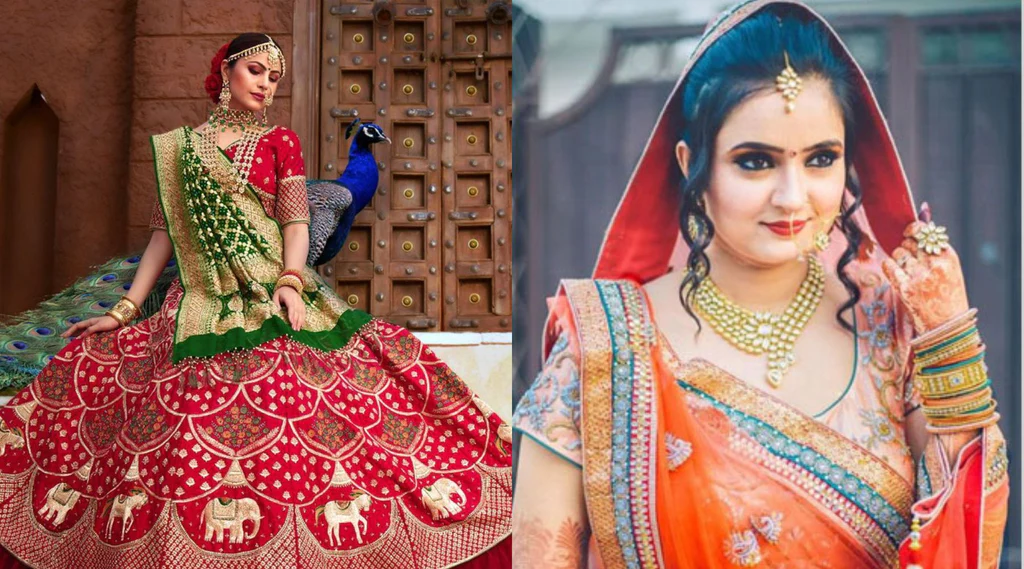
- Jacket over Sari Draping
To achieve a smart-casual or modern formal look, some choose to sport a jacket with the sari, showcasing the fusion of traditional and contemporary fashion.
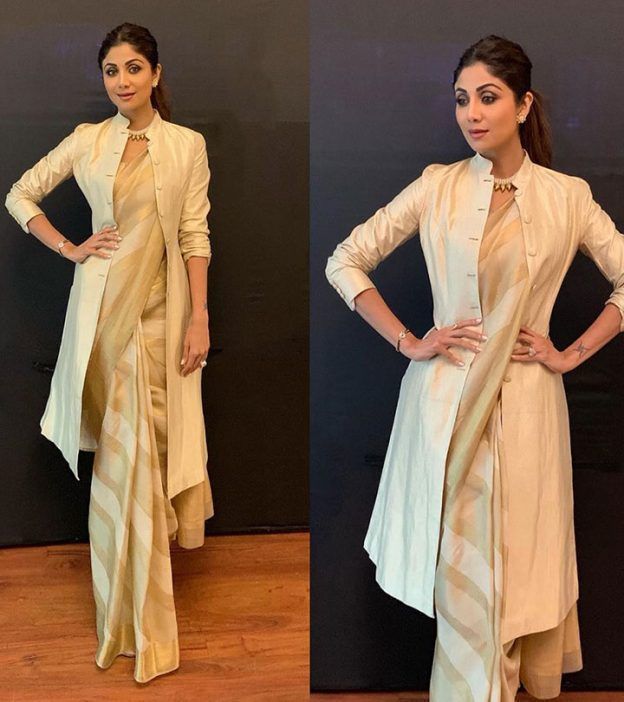
- Pant Style Sari Draping
A current and trendy style involves pairing the sari with pants or jeggings, offering a fusion of traditional and modern attire.
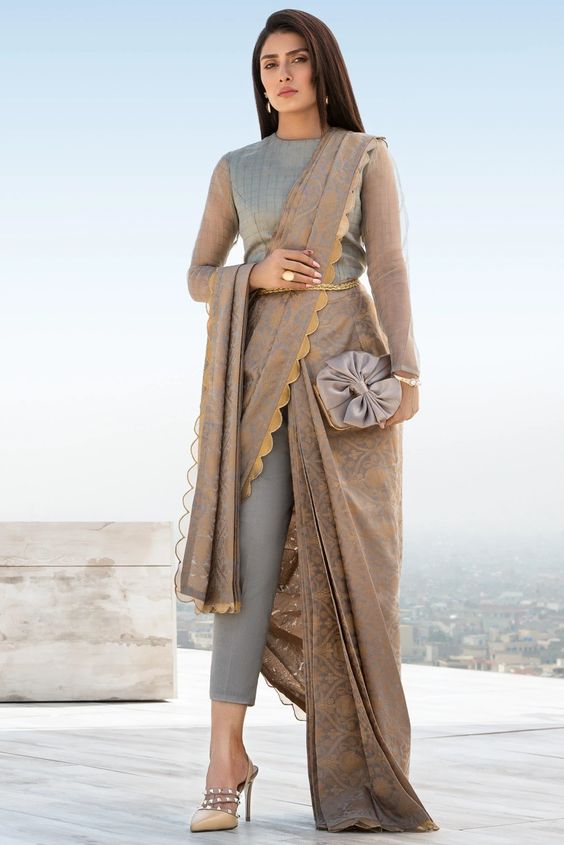
- Mermaid Style Draping
The mermaid style draping provides a flattering look, characterized by a close fit at the hip section and a flared hem.
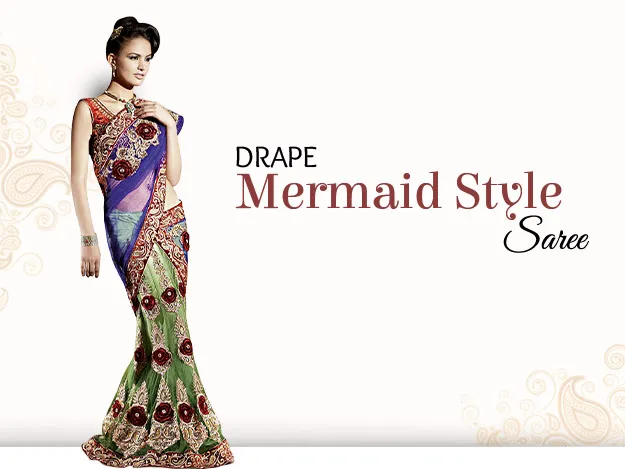
- Marathi/Laavani Style
Traditional Maharashtra saris, measuring 8 meters, are draped with one portion lifted between the legs and tucked behind at the waist, while another portion forms the pallu draped over the shoulder.
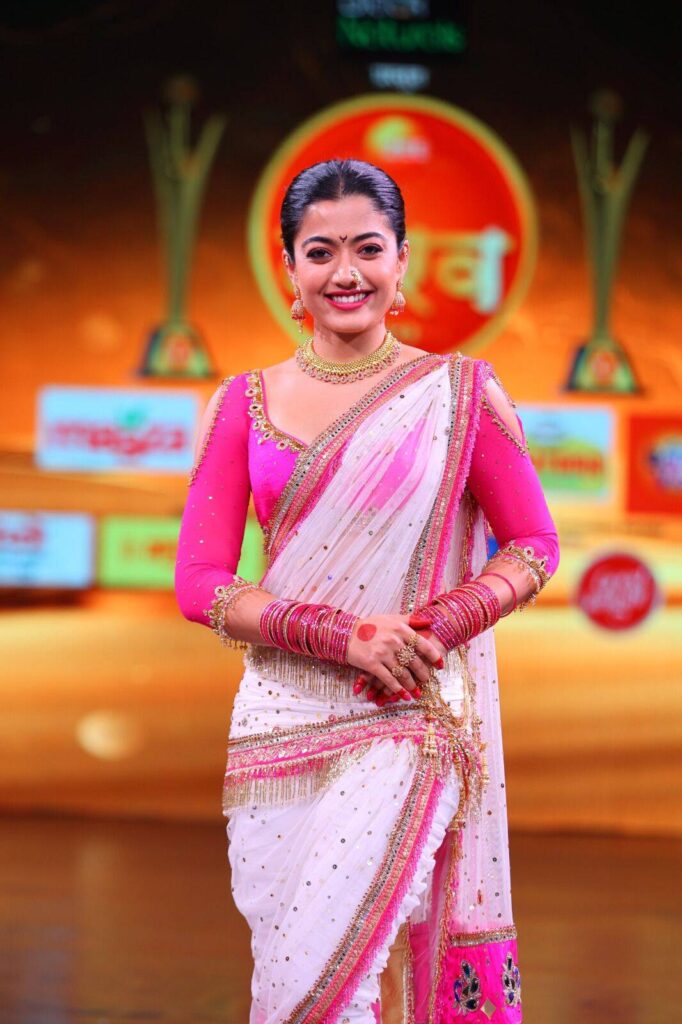
- Bengali Style
Traditional Bengali saris are typically white with a red border. Wide box pleats are tucked at the front, and the pallu is taken over the left shoulder.

- Coorgi or Kodagu Style
Unique to the Coorg region, this style involves creating pleats at the back for free leg movement. The pallu is wrapped around the front chest and brought over the shoulder from the back.
- Oriya Style
Following a basic pleating procedure for the lower body, the pleated pallu is pinned on the left shoulder in the Oriya style.

- Lehenga Style Sari Draping
Popular in North India, this style mimics the drape of a lehenga, offering a unique and fashionable twist to traditional sari draping.
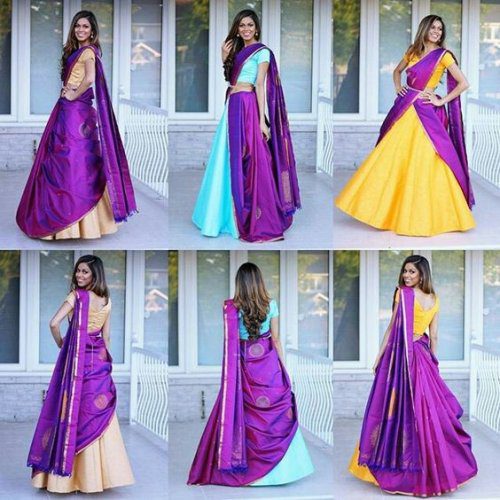
- Rajrani Style Sari Draping
Emulating the draping styles of royalty, the Rajrani style exudes elegance and regality.

- Kerala Style
Traditional Kerala attire comprises a sari with colors ranging from pure white to cream and a gold border. The ensemble consists of two pieces: the Mundu draped on the lower body and the Neriyathu worn over the left shoulder.
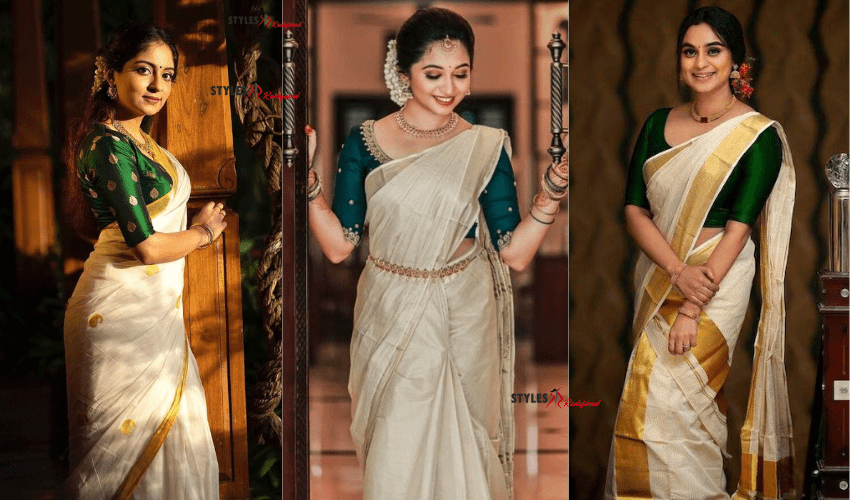
- Tamilian Iyer Style
Bordered sarees in the Tamilian Iyer style are wrapped around the waist, with pleats positioned at the left waistline. The rest of the sari is taken over the shoulder and wrapped around the waist.

- Rajasthani Style
Rajasthani draping styles encompass various patterns such as Bandhni and Leheriya on both sarees and ghagra cholis, characterized by vibrant colors and intricate designs.

- Enkei Style
A typical Andhra Pradesh attire, the Enkei style resembles a dhoti. Pleats are tucked at the back of the waist, and the pallu is pulled over the shoulder, wrapped around the waist.
- Assam Style Sari Draping
Known as Mekhla Chadar, the Assam style comprises two pieces: the Mekhla, a flowing skirt, and the Chadar, an upper wrap similar to Anchal, worn in a criss-cross pleated form down the front.
- Chhattisgarh Style
Featuring unusual and interesting draping techniques, the Chhattisgarh style stands out with its unique approach to sari draping.
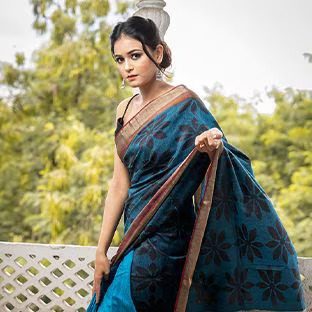
- Dhoti Style Sari Draping
Drawing inspiration from Maharashtra, the Dhoti style involves draping the sari around the waist, with the longer section brought from the back to the front, showcasing distinctive cowls for a dhoti finish.
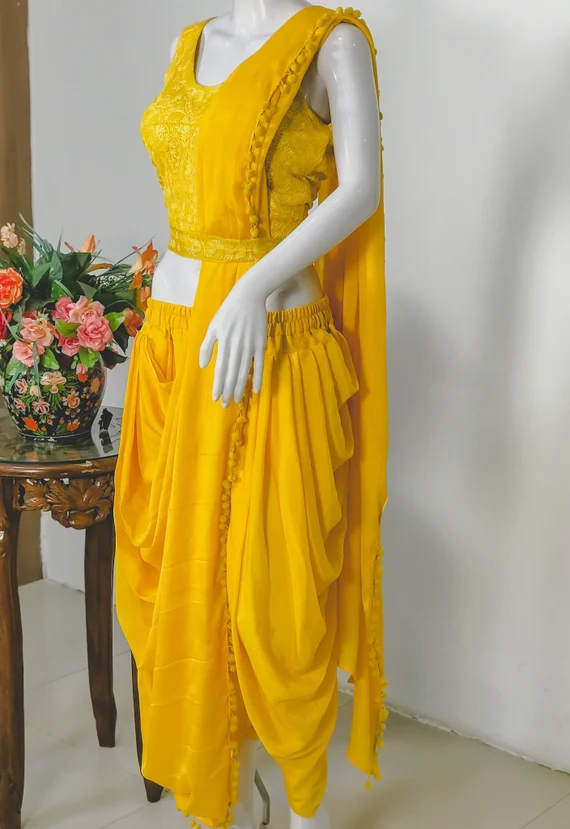
Bangladeshi Style Sari Draping
In Bangladesh, the sari, often referred to as “sharee,” is a traditional and culturally significant attire for women. The Bangladeshi style of sari draping is influenced by the regional culture and preferences. Key features include:

Tant and Jamdani Sari
Tant and Jamdani are popular traditional weaves used in Bangladeshi saris. Tant saris are known for their handwoven cotton fabric, while Jamdani involves intricate geometric and floral patterns.
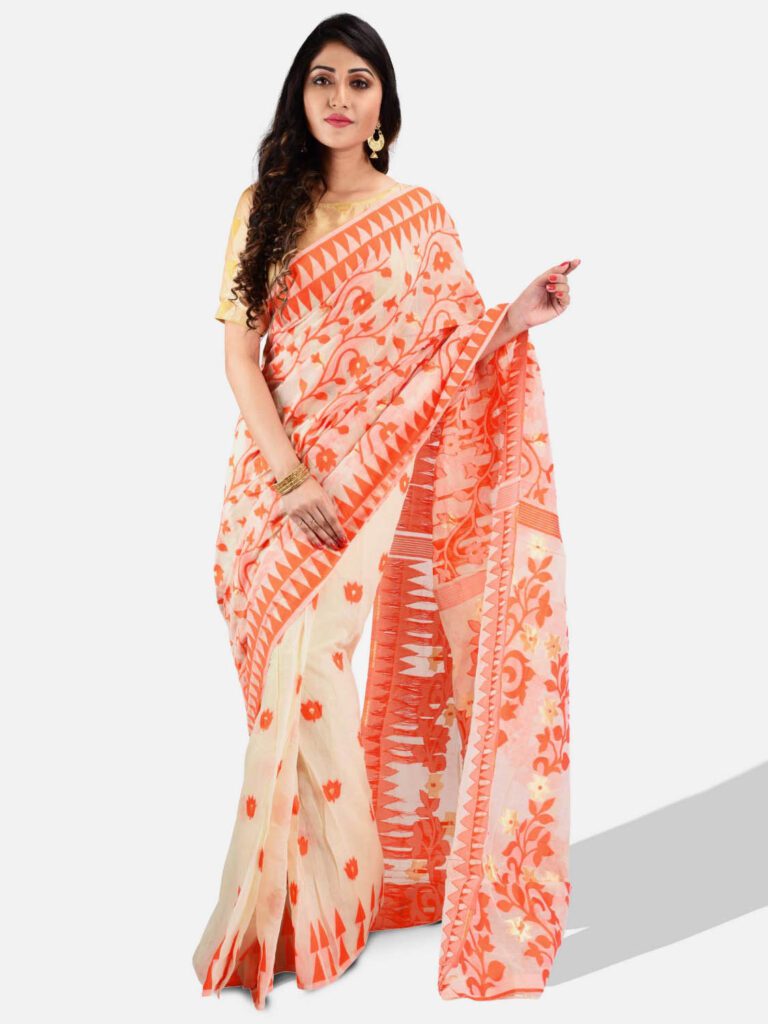
Pallu Draping
The pallu in Bangladeshi saris is often draped with attention to detail, showcasing the beauty of the fabric and any embellishments. The pallu may be adorned with artistic designs, making it an integral part of the overall look.

Traditional Embroidery
Embroidery work, including kantha stitching, is commonly seen in Bangladeshi saris. These embellishments add a touch of cultural richness and elegance to the attire.

Nepali Style Sari Draping
In Nepal, the sari is known as “haku patasi.” The Nepali style of sari draping is influenced by regional traditions and cultural diversity. Key features include:

Gunyu Cholo Style
The traditional Gunyu Cholo style involves draping the sari with a specific type of blouse known as Cholo. This style is often worn during cultural events and celebrations.

Rich Fabrics and Colors
Nepali saris are crafted from rich fabrics, and the choice of colors varies based on cultural significance and personal preferences. Bright and vibrant colors are often favored.

Draping for Festivals
During festivals and special occasions, Nepali women may drape the sari in unique ways, incorporating cultural symbols and patterns that hold religious or cultural significance.
Sri Lankan Style Sari Draping
In Sri Lanka, the sari is an integral part of traditional attire for women. The Sri Lankan style of sari draping is characterized by its unique features. Key aspects include:
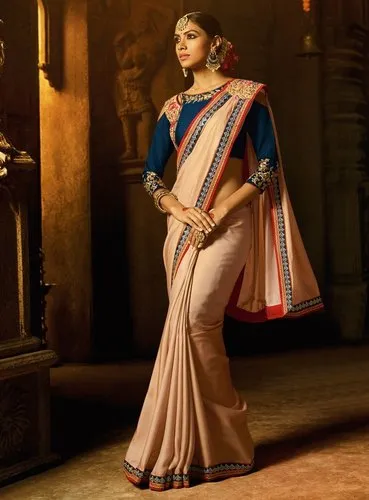
Kandyan Sari Draping
The Kandyan style of draping involves wearing the sari with a Kandyan-style blouse, creating a distinctive and elegant look. This style is commonly seen during traditional ceremonies.
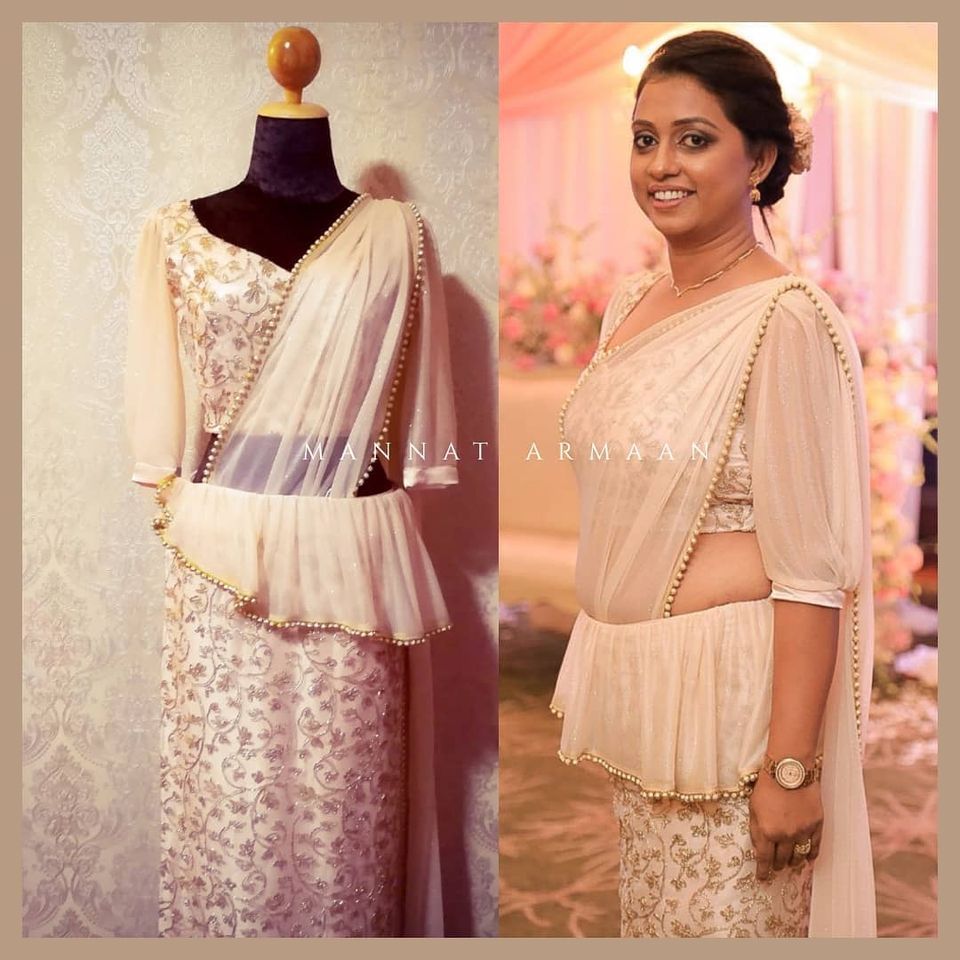
Rich Embellishments
Sri Lankan saris often feature intricate embellishments such as hand embroidery, beadwork, and metallic threads. These embellishments add a touch of glamour to the attire.

Final Thoughts
In the contemporary fashion landscape, the saree has gracefully embraced creative design and modern styles while retaining its timeless essence. A symbol of grace and versatility, the saree has transcended trends and remains a staple in every Indian wardrobe.
For those seeking the perfect ensemble, the quest for a “saree shop near me” or “sarees near me” is a common pursuit. The modern saree, with its fusion of traditional craftsmanship and contemporary aesthetics, caters to diverse tastes. Whether it’s a fancy saree or one on saree sale, the saree continues to be a go-to choice, embodying the cultural heritage preserved by women throughout history.
Its evolution reflects not just a garment, but a testament to the enduring role of women in safeguarding traditional art.
-
 Maria B Stitched saree Couture Red MC 051 LATEST Collection 2024$125.00 – $159.99
Maria B Stitched saree Couture Red MC 051 LATEST Collection 2024$125.00 – $159.99 -
 Maria B Stitched Saree Couture Pale Pink MC 050$159.99
Maria B Stitched Saree Couture Pale Pink MC 050$159.99 -
 Maria b MBROIDERED Stiched Organza Grey and Black Saree (BD-2504)$299.99
Maria b MBROIDERED Stiched Organza Grey and Black Saree (BD-2504)$299.99 -
 Maria B Stitched Ice Blue Saree Latest Collection 2023$170.00
Maria B Stitched Ice Blue Saree Latest Collection 2023$170.00 -
 Light Brown Wedding Collection Saree 2024$180.00
Light Brown Wedding Collection Saree 2024$180.00 -
 Pakistani Wedding Collection saree 2024$199.99
Pakistani Wedding Collection saree 2024$199.99 -
 MARIA B STICHED CHIFFON MBROIDERED BLUE & GREY SAREE$130.00 – $160.00
MARIA B STICHED CHIFFON MBROIDERED BLUE & GREY SAREE$130.00 – $160.00 -
Product on sale
 Velvet Saree Blouse for Bridal Wear – Luxurious Bridal Collection$249.00 – $299.00
Velvet Saree Blouse for Bridal Wear – Luxurious Bridal Collection$249.00 – $299.00 -
 Maria B BD2801 Saree Embroidered Chiffon Saree$280.00 – $350.00
Maria B BD2801 Saree Embroidered Chiffon Saree$280.00 – $350.00


